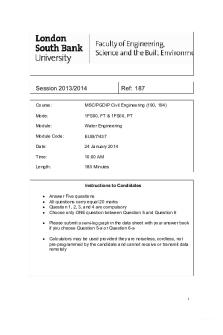Exam 24 January 2014, questions and answers PDF

| Title | Exam 24 January 2014, questions and answers |
|---|---|
| Course | Water Engineering |
| Institution | London South Bank University |
| Pages | 29 |
| File Size | 1.5 MB |
| File Type | |
| Total Downloads | 203 |
| Total Views | 491 |
Summary
Session 2013/2014 Ref: 187 Course: MSC/PGDIP Civil Engineering (190, 194) Mode: 1FS00, FT & 1FS00, PT Module: Water Engineering Module Code: EUB/7/437 Date: 24 January 2014 Time: 10:00 AM Length: 180 Minutes Instructions to Candidates Answer Five questions All questions c...
Description
Session 2013/2014
Ref: 187
Course:
MSC/PGDIP Civil Engineering (190, 194)
Mode:
1FS00, FT & 1FS00, PT
Module:
Water Engineering
Module Code:
EUB/7/437
Date:
24 January 2014
Time:
10:00 AM
Length:
180 Minutes
Instructions to Candidates
Answer Five questions All questions carry equal 20 marks Question 1, 2, 3, and 4 are compulsory Choose only ONE question between Question 5 and Question 6
Please submit a semi-log graph in the data sheet with your answer book if you choose Question 5-a or Question 6-a
Calculators may be used provided they are noiseless, cordless, not pre-programmed by the candidate and cannot receive or transmit data remotely
1
QUESTION 1 (1-a) Describe the following terms: Storage coefficient (storativity) Hydraulic head
(2 marks) (2 marks)
(1-b) A fully penetrating well discharge 0.29m3/min from an unconfined aquifer. The original water table was recorded as 10.7 m. After a long time period, the water table was recorded as 9.1m in an observation well located 22.8m away and 10.5m at an observation well located 610m away. Determine the hydraulic conductivity of this aquifer in metre per second. (4 marks) (1-c) A confined aquifer has the storativity of 2.31 x 10–4. How much water would it yield from groundwater if the water table declined an average of 1.3m over a circular area with a radius of 127.4m? (3 marks)
(1-d) There is spill of a conservative contaminant into the subsurface. The spill infiltrates the unsaturated zone and quickly reaches the underlying water table aquifer. The aquifer consists mainly of sand and gravel with a hydraulic conductivity of 0.15 cm/s and an effective porosity of 0.25. The water level in a well neighbouring the spill lies at an altitude of 80m, and the level in another well 1500m directly down gradient is 55m. 1) Calculate the velocity of the contaminant in metre per day. (3 marks) 2) Estimate how long it will take for the contaminant reach the down-gradient well in days. (1 mark)
(1-e) An earthen dam is constructed on an impermeable bedrock layer. It is 167m across (i.e., the distance from the water in the reservoir to the tailwaters below the dam is 167m. The average hydraulic conductivity of the material used in the dam construction is 0.237m/d. The water in the reservoir behind the dam is 10.7m deep and the tailwaters below the dam are 6.1m deep. Compute the volume of water that seeps from the reservoir through the dam with a 30.5m-wide strip of the dam in cubic metre per day. (5 marks)
2
QUESTION 2 (2-a) A confined aquifer has 36m thick and 7km wide above the bottom confining rock layer. The aquifer is medium sand with a hydraulic conductivity of 1.8m/d. Hydraulic heads of 95m and 86m are observed at two non-pumping monitoring wells located at 300m and 1600m, respectively, from the pumped well. 1) Calculate the total flow of groundwater flow thought the aquifer. (3 marks) 2) What is the hydraulic head at a point located 0.3km from well 1 and 0.9km well 2? (3 marks)
(2-b) A leaky 4.5-m3 underground storage tank was removed. The excavation resulted in a tank pit of 4m × 4m × 5m (L× W × H), and the excavated soil was stockpiled on site. Three samples were taken from the pile and the total petroleum hydrocarbon (TPH) concentrations were determined to be...
Similar Free PDFs

Exam January 2014, questions
- 9 Pages

Exam January 2014, questions
- 4 Pages

Exam 2014, questions and answers
- 23 Pages

EXAM 2014, questions and answers
- 18 Pages

Exam 2014, questions and answers
- 22 Pages

Exam 2014, questions and answers
- 15 Pages

Exam 2014, questions and answers
- 4 Pages

Exam 2014, questions and answers
- 6 Pages

Exam 2014, questions and answers
- 12 Pages

Exam 2014, questions and answers
- 9 Pages

Exam 2014, questions and answers
- 11 Pages
Popular Institutions
- Tinajero National High School - Annex
- Politeknik Caltex Riau
- Yokohama City University
- SGT University
- University of Al-Qadisiyah
- Divine Word College of Vigan
- Techniek College Rotterdam
- Universidade de Santiago
- Universiti Teknologi MARA Cawangan Johor Kampus Pasir Gudang
- Poltekkes Kemenkes Yogyakarta
- Baguio City National High School
- Colegio san marcos
- preparatoria uno
- Centro de Bachillerato Tecnológico Industrial y de Servicios No. 107
- Dalian Maritime University
- Quang Trung Secondary School
- Colegio Tecnológico en Informática
- Corporación Regional de Educación Superior
- Grupo CEDVA
- Dar Al Uloom University
- Centro de Estudios Preuniversitarios de la Universidad Nacional de Ingeniería
- 上智大学
- Aakash International School, Nuna Majara
- San Felipe Neri Catholic School
- Kang Chiao International School - New Taipei City
- Misamis Occidental National High School
- Institución Educativa Escuela Normal Juan Ladrilleros
- Kolehiyo ng Pantukan
- Batanes State College
- Instituto Continental
- Sekolah Menengah Kejuruan Kesehatan Kaltara (Tarakan)
- Colegio de La Inmaculada Concepcion - Cebu




